-
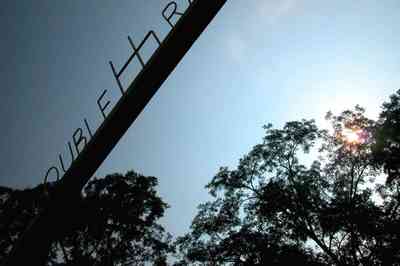
The ranch is located on Highway 87 North.
-
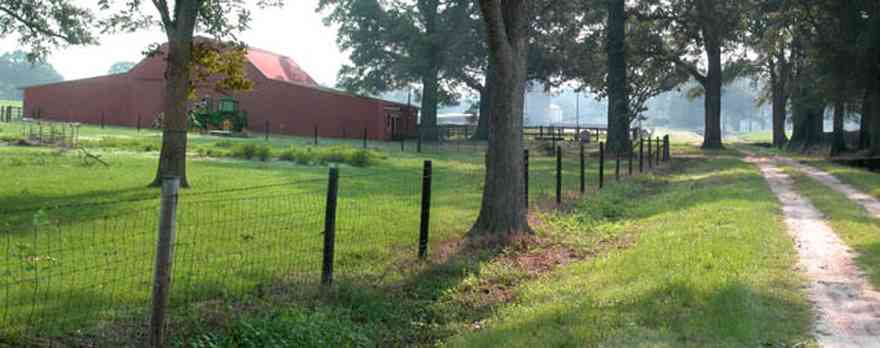
The picturesque ranch is a cattle farm.
-
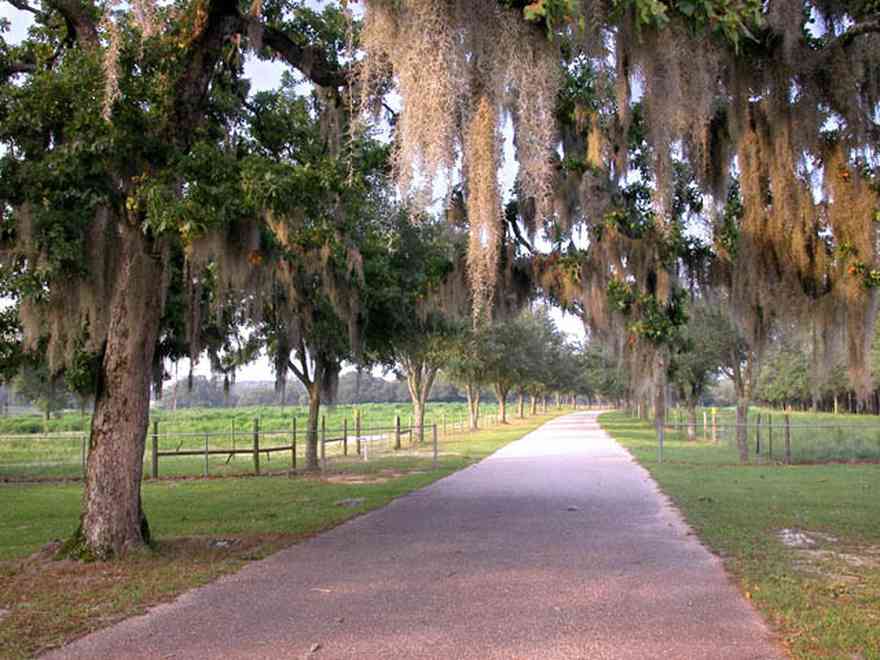
-
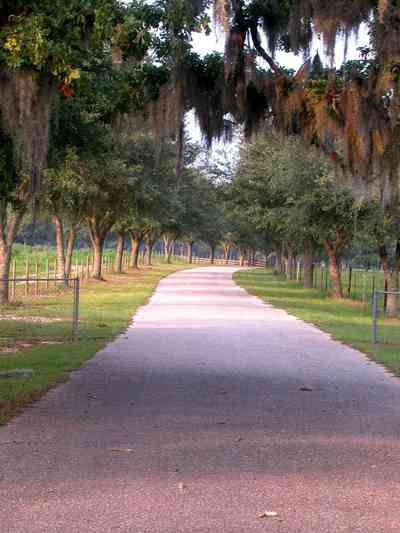
-
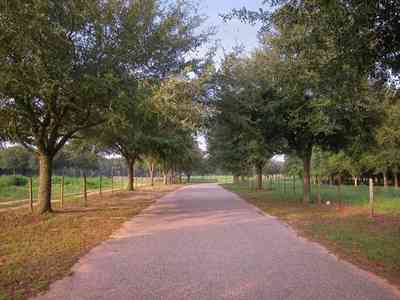
-

-
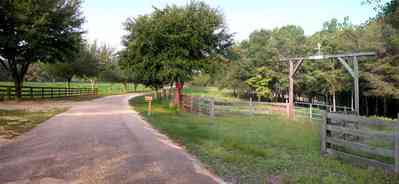
-
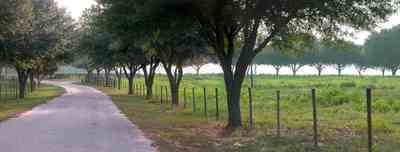
-
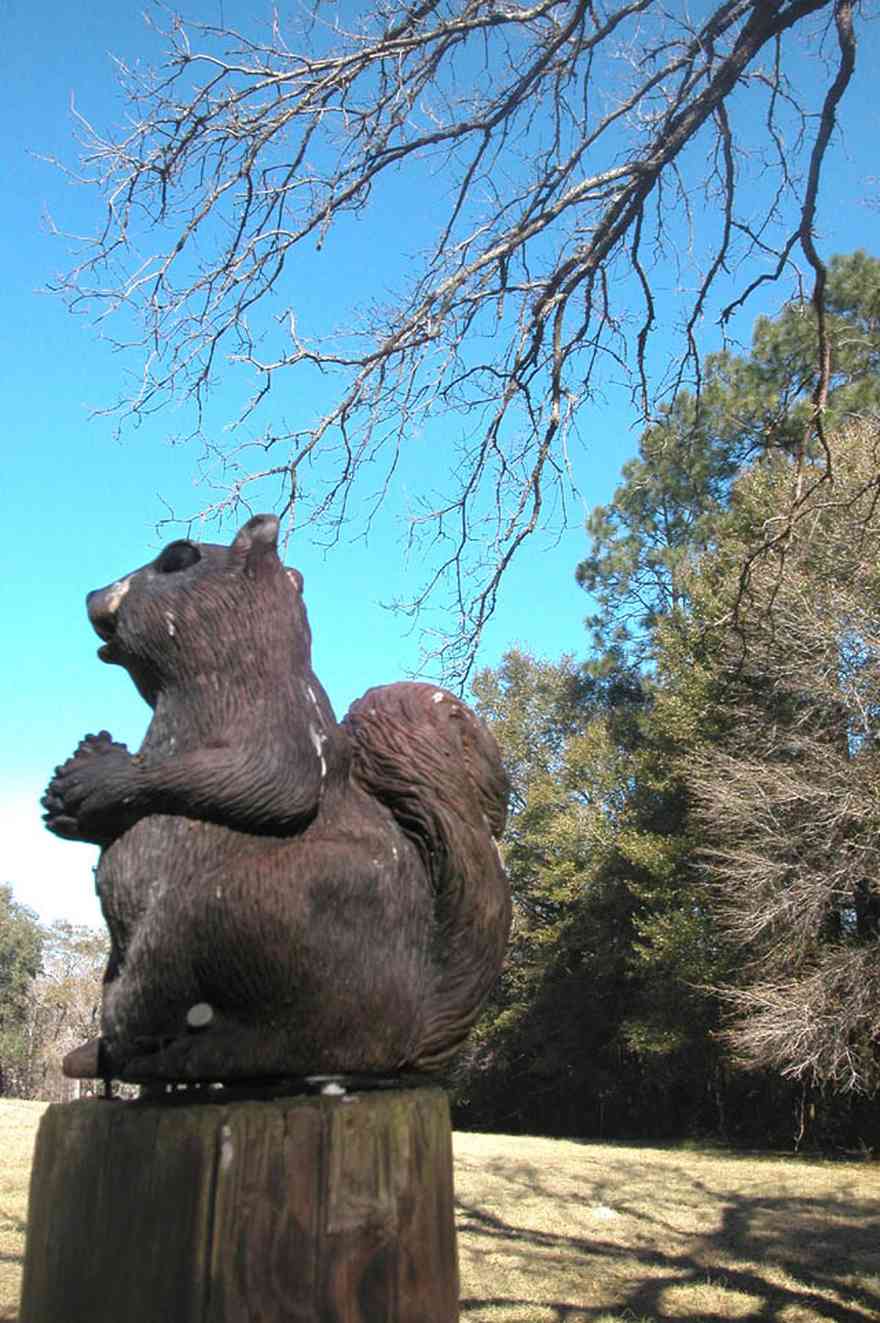
Whimsical sculptures and signs can be found on the Matthews farm.
-
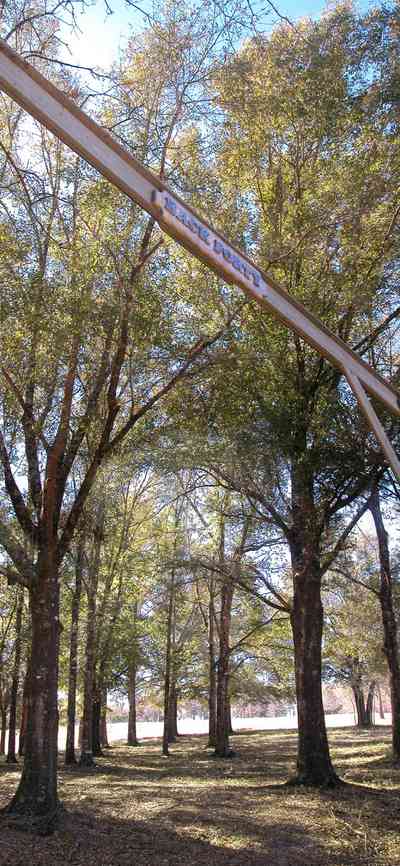
The property is divided into fenced tracts.
-
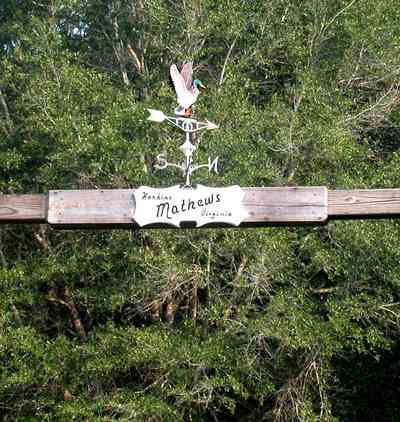
The farm is located on Hopewell Road.
-
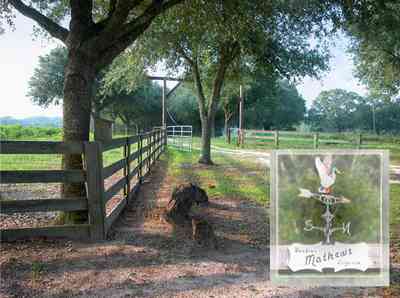
There are two entrances on either side of Hopewell Road. This is the south gate.
-
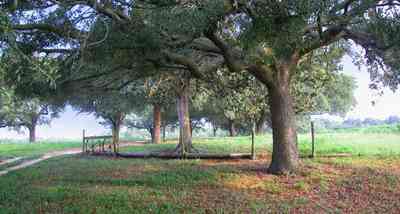
The south road is lined by an avenue of young live oak trees.
-
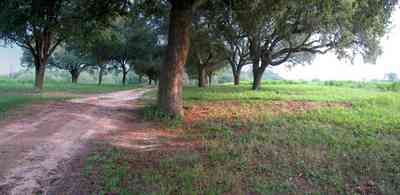
The narrow dirt road is a private driveway.
-
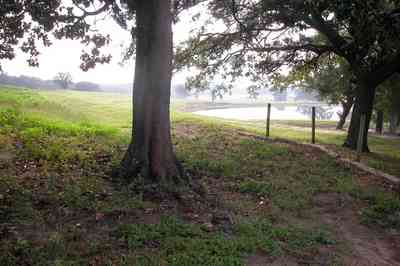
The road follows the gently rolling hills.
-
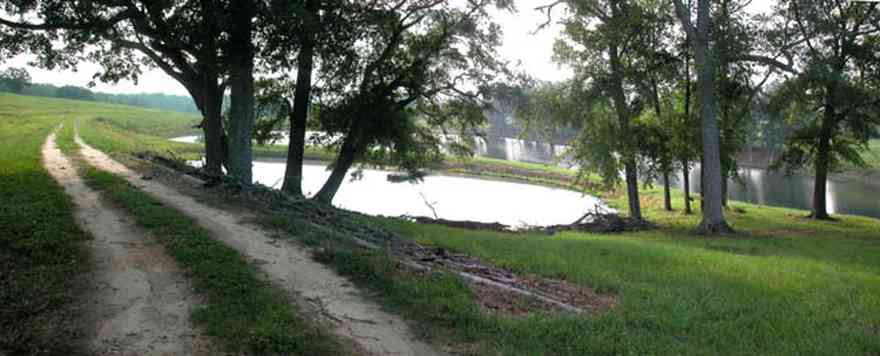
There are several lakes in the valley. The road winds around the lakes.
-
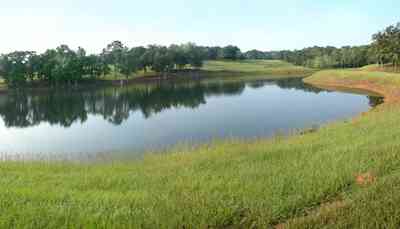
-
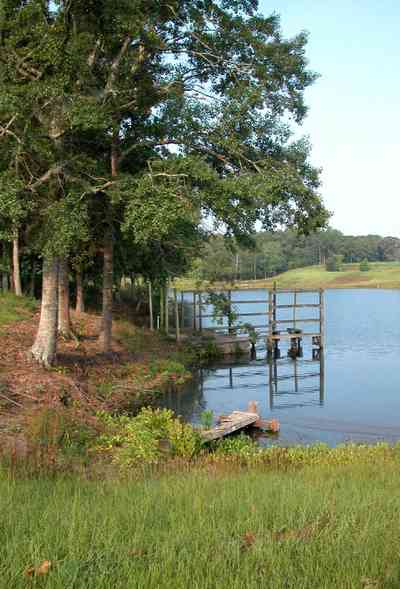
-

The highway curves around newly planted fields.
-
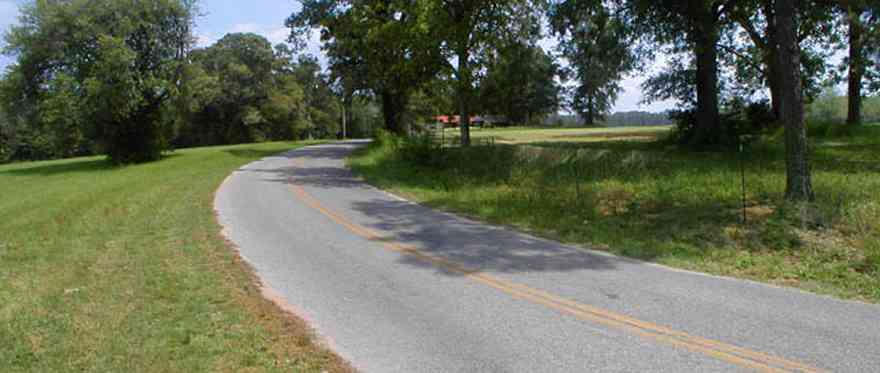
The farmland is located on a ridge of hills above the Blackwater River basin.
-

The front of the farm faces Kleinschmidt Road. The deciduous trees are pecans. There is a grove along the property line on the east side of the farm. The Heil home is a small craftsman cottage in the center of the frame.
-

A dirt road runs alongside of the east field. Rolls of irrigatioin equipment and outbuildings can be seen in the right side of the frame. The greens can be seen int he center. There is a utility line alongside on the far left.
-

The utility buildings and irrigation equipment can be seen in the distance along the tree line.
-

-
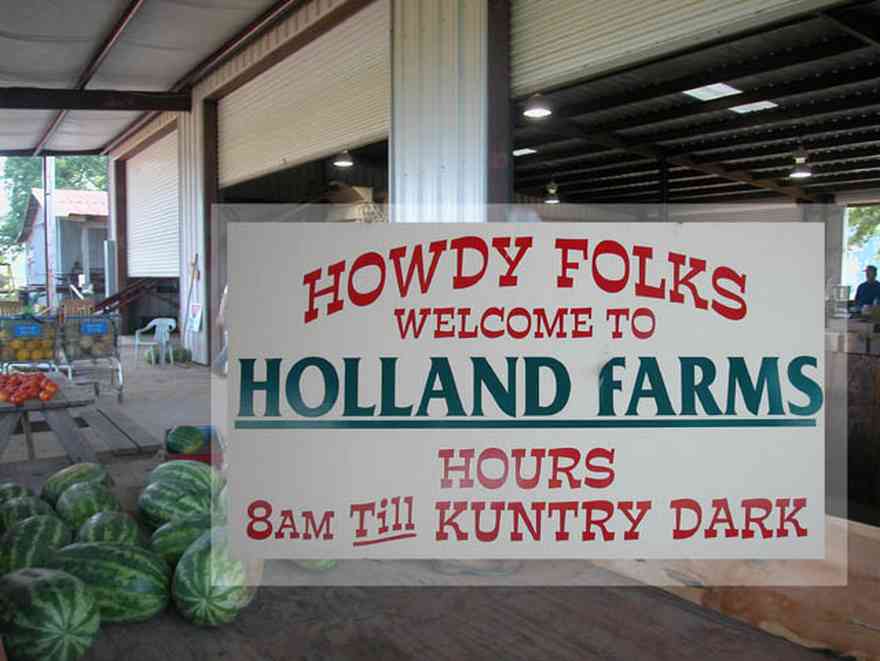
Piles of watermelons are purchased from July to August at the barn.
-
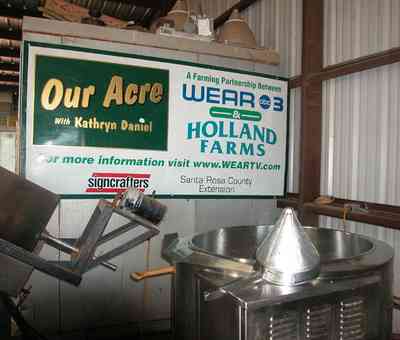
Bruce and his family have a complete peanut harvest from planting through boiling.
-
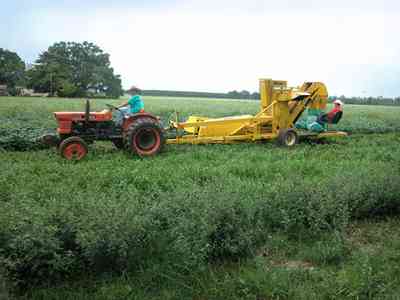
The 600 acre farm is divided into summer crops. The butterbean field is adjacent to the barn.
-
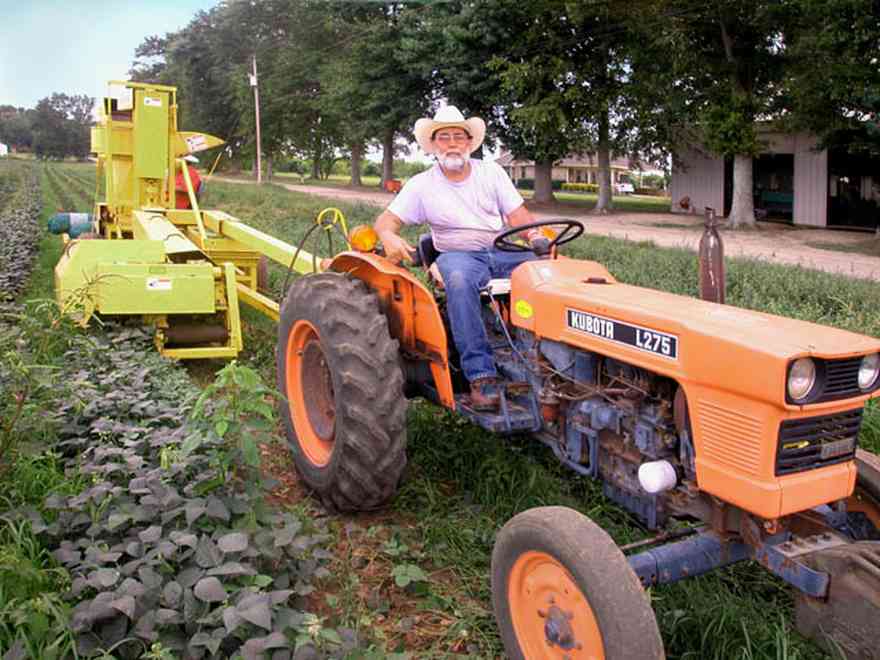
Melvin Holland lends a hand during the butterbean harvest.
-
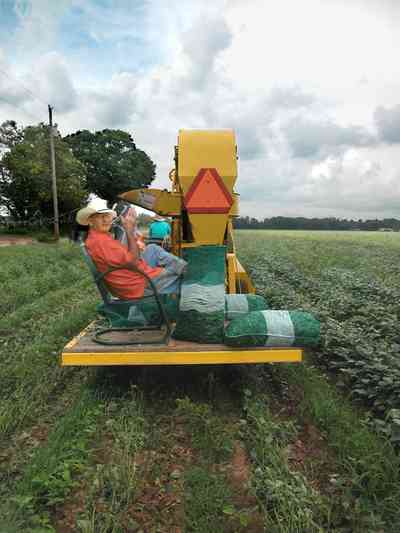
Charles Holland supervises the bagging of beans.
-

Bruce Holland demonstrates soil quality in one of the north fields. The tilled area represents about five acres.
-
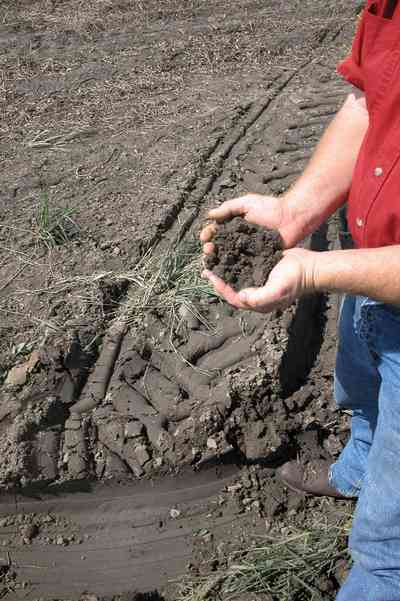
The field is being prepared for the next crop. Soil composition varies widely from field to field. The soil in this area has a high organic content. Soils are composed of sand, clay and organic materials.
-

The entrance to the barn and house is on the far right of the photograph. The 5 acre tilled field can be seen on the other side of the road.
-
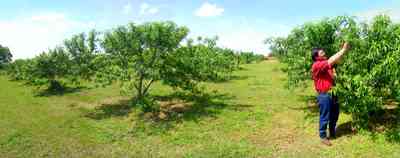
The Bruce Holland farm complex is located on Homer Holland Road in Santa Rosa County, Florida. The peach trees seen in the photo produce about six bushels/60 pounds or 120 one-half pound peaches per tree.
-
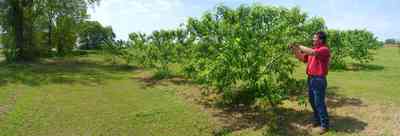
Bruce Holland is seen in the foreground of his peach orchard in northwest Florida. The trees have been planted in symmetrical rows every year for the past six years. The orchard has approximately 200 trees, all bearing fruit.
-
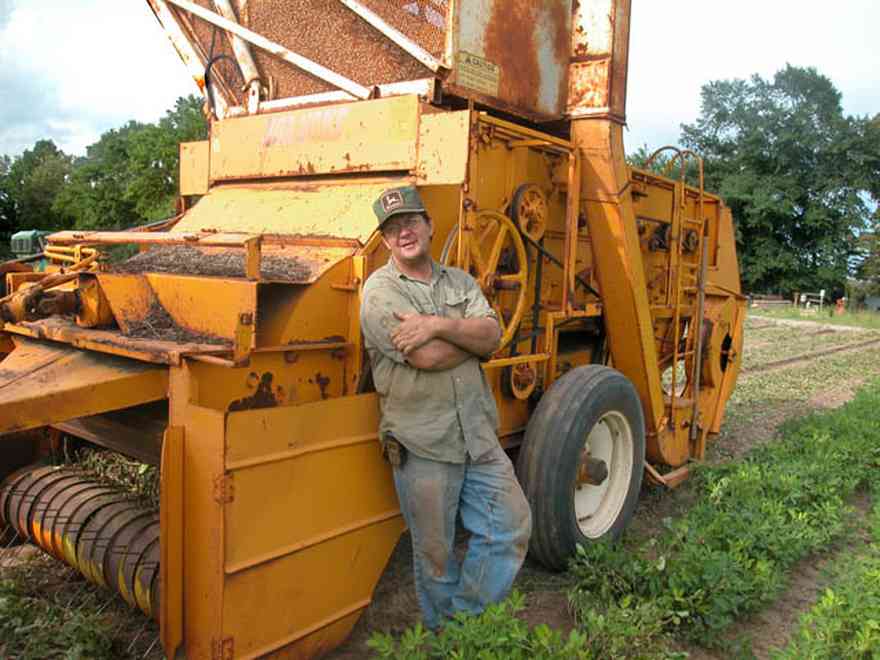
The peanut is a nitrogen-fixing plant. The roots form nodules, which absorb nitrogen from the air and provide enrichment and nutrition to the plant and soil.
-
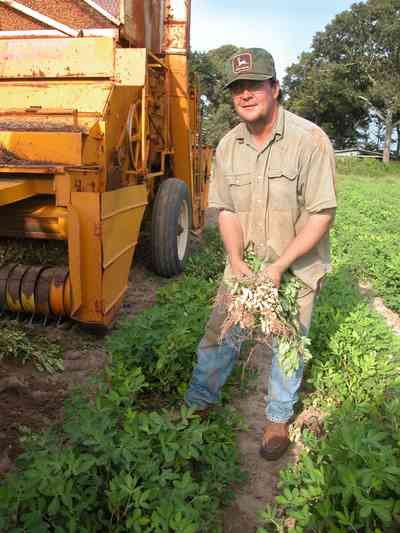
From planting to harvesting the growing cycle takes about four to five months, depending on the variety.
-

Peanuts are actually legumes - not nuts.
-
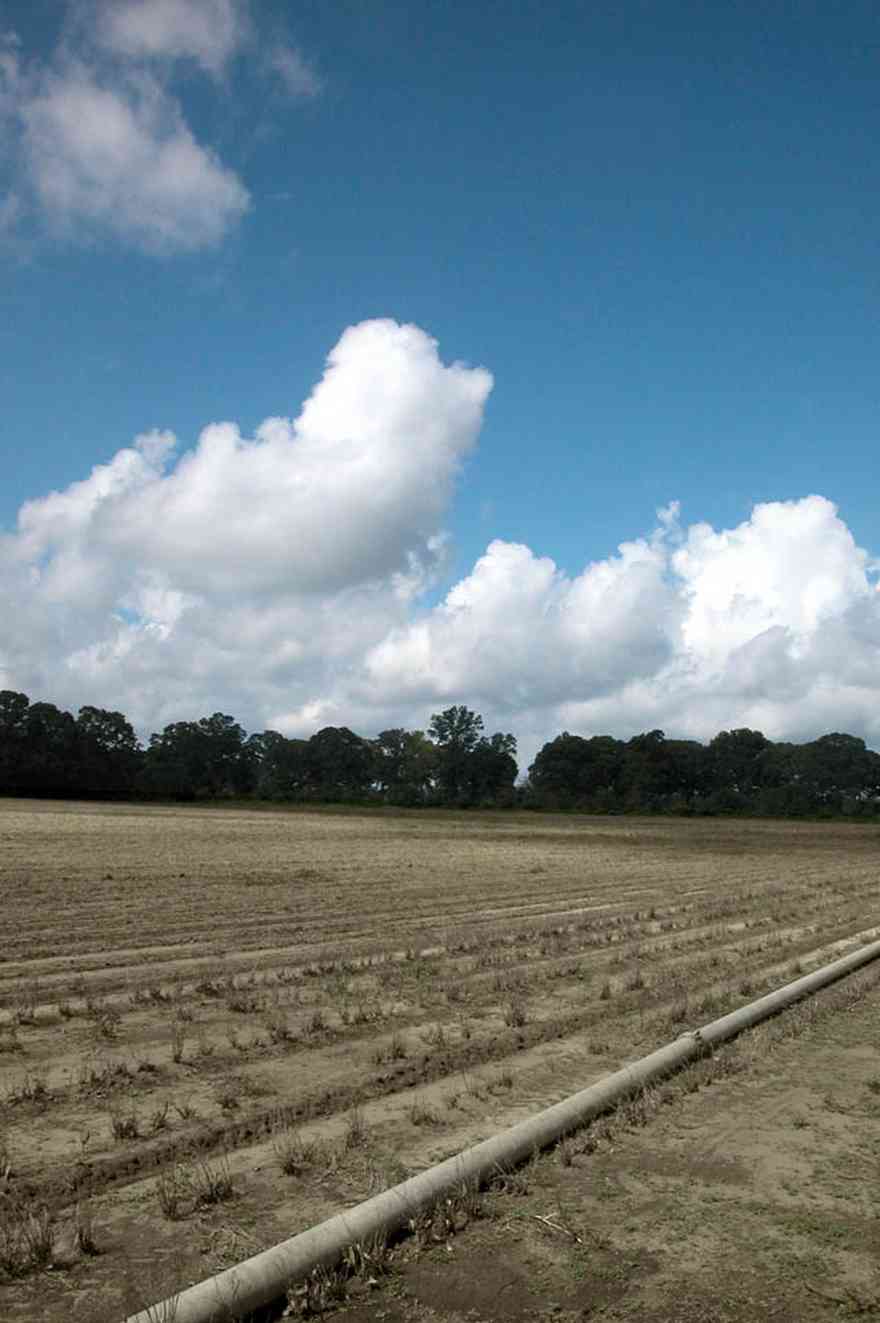
This 15 acre field was planted in butterbeans. It is irrigated with water from a nearby holding pond.
-
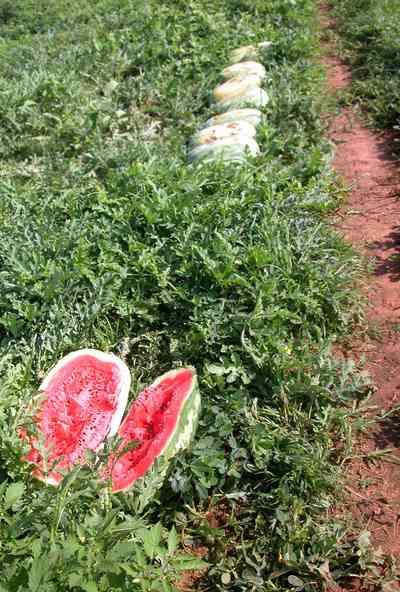
On the American continent, watermelons were grown as early as 1629 in Massachusetts, and prior to 1664 in Florida.
-
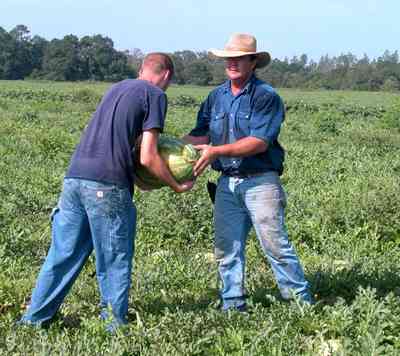
Today there are more than 100 different varieties of watermelons. The flesh may be red, pink, orange or yellow.
-
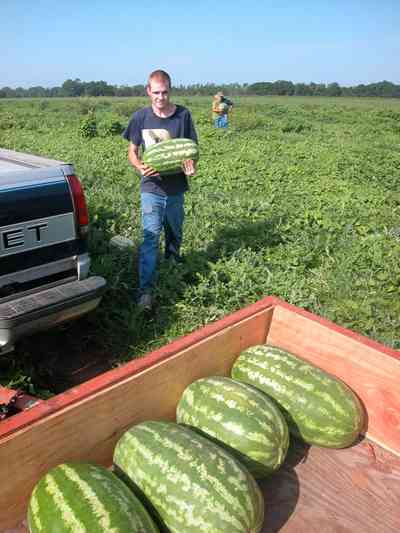
The sweetest watermelons grow during long hot summers.
-
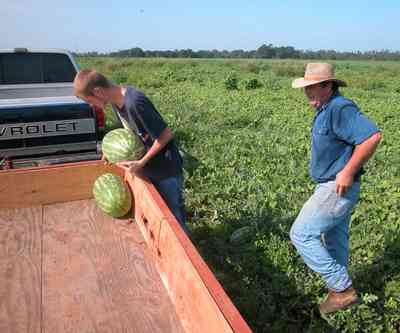
Ninety percent of watermelon is water.
-
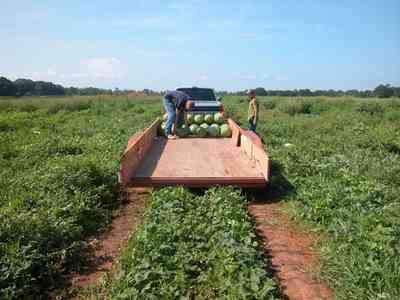
Watermelon vines require considerable space. Seeds are planted one inch deep in hills spaced 6 feet apart. As the watermelon plants grows, the vines converge and the field becomes a sea of green vines.
-
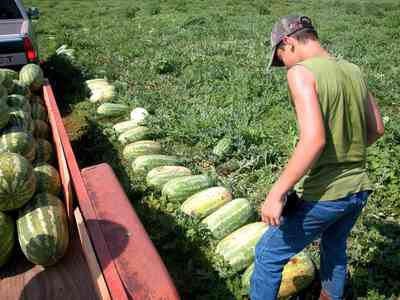
The watermelon require a long growing season with relatively high temperatures. Daytime temperatures between 70 and 80 degrees F and nighttime temperatures between 65 and 70 degrees F are ideal.
-
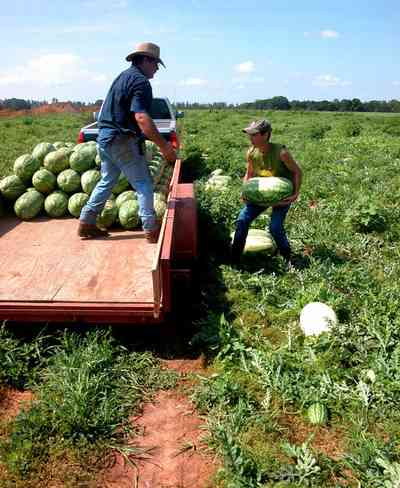
Once picked, uncut watermelon can be stored for about 2 weeks at room temperature.
-
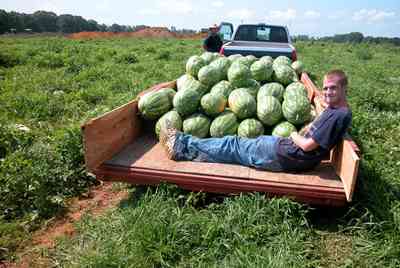
The flesh of the melon should be deep colored with mature seeds. Most watermelons have dark brown or black seeds.
-
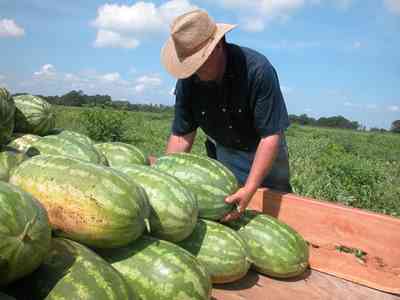
Harvesting is particularly critical because watermelons do not continue to ripen after they have been removed from the vine. They should be picked at full maturity.
-
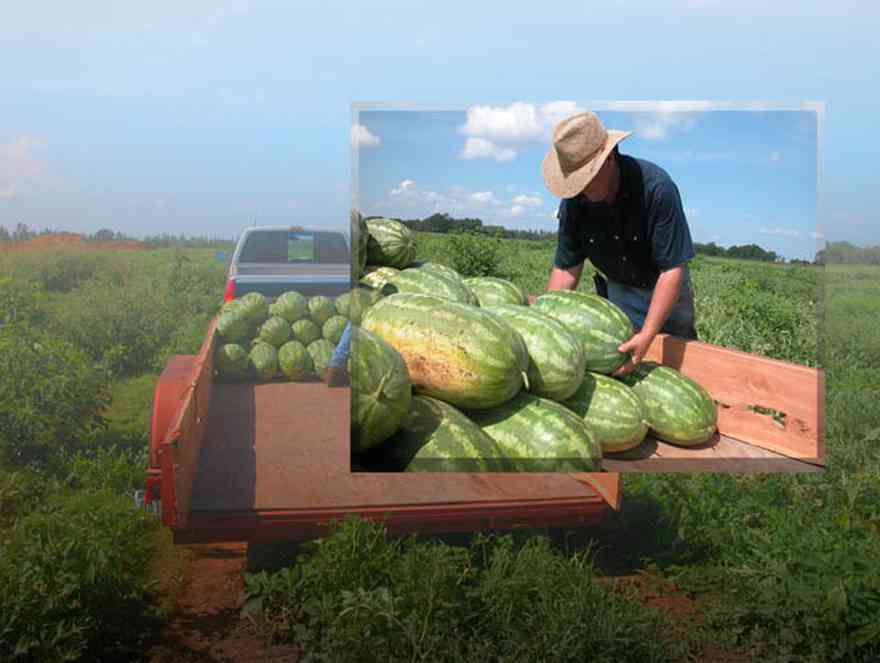
Watermelons are low in calories and very nutritious. Watermelon is high in lycopene, second only to tomatoes.
-

The Holland family settled the area over 100 years ago. Bruce Holland is a well known farmer who sells produce at his barn on Hwy 178. His farm has been featured on the WEAR TV 3 feature "Our Acre".
-

The church is located at the corner of Chumukla Highway and 178.
-
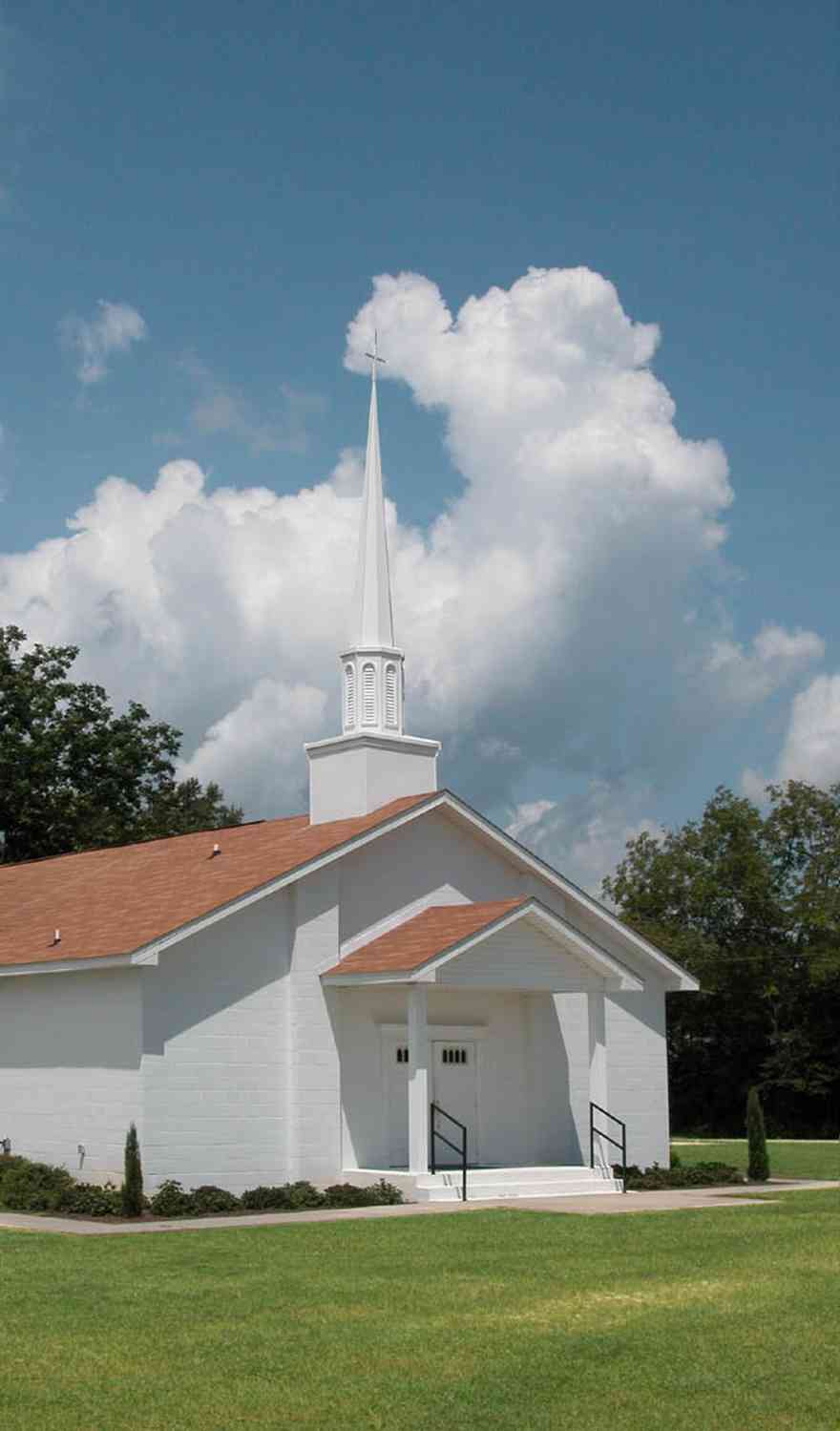
The little church is nestled between cotton fields in western Santa Rosa County.
-
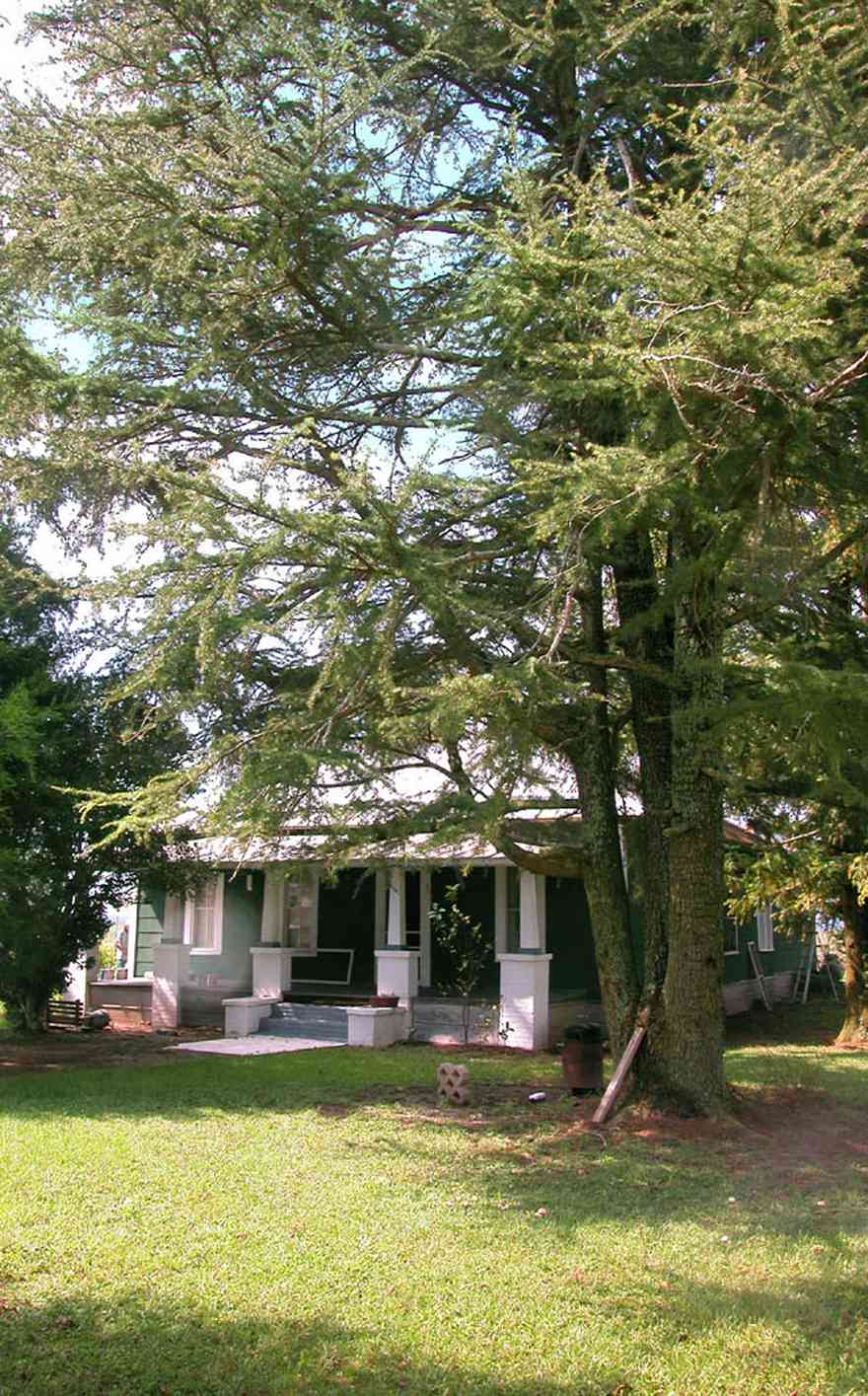
The craftsman style cottage is evocative of the farm houses of the 1920's and 30's. It sits on the edge of a cotton field.
-

Melvin Holland sells peanuts at the festival.
-

There is a display of John Deere® tractors alongside of the farm museum.
-
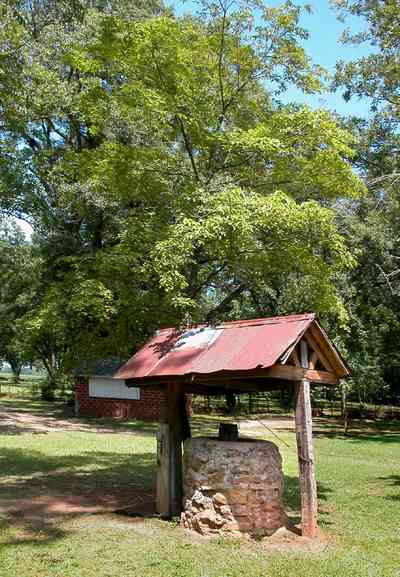
An original water well is located east of the farm house.
-
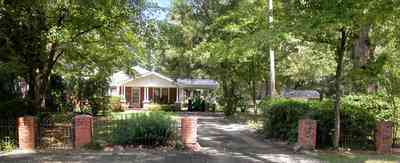
-
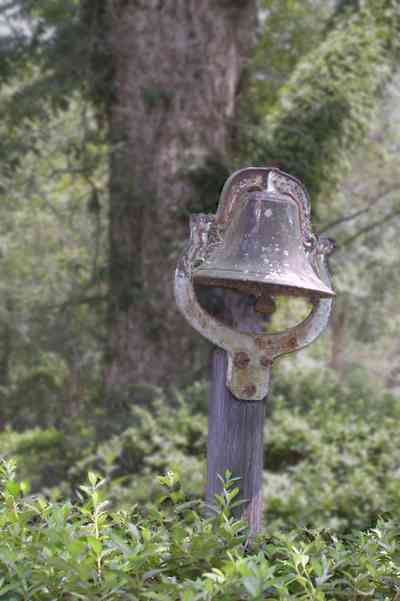
-
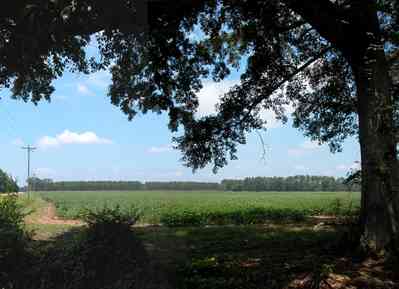
-
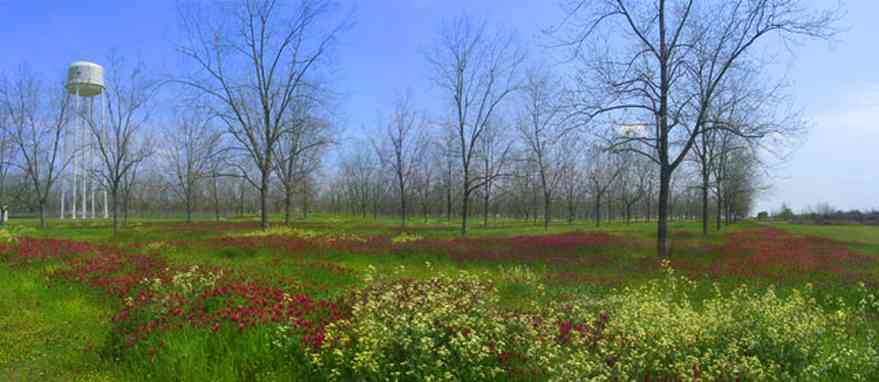
-
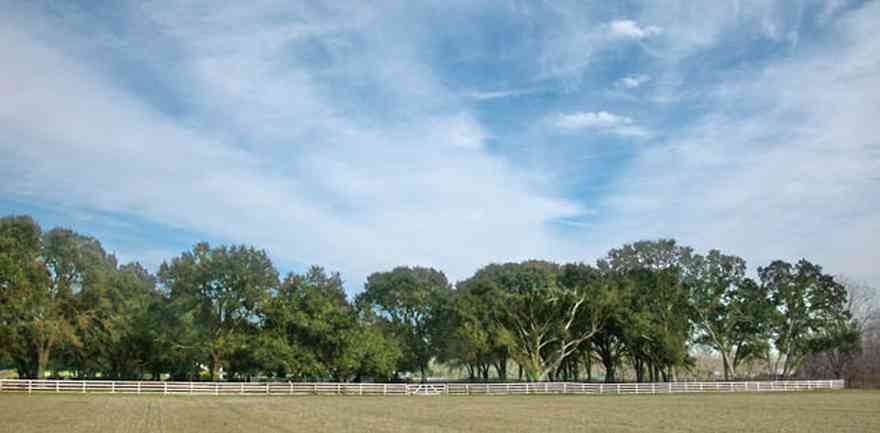
The board fence separates the horse farm from the neighboring estate.
-
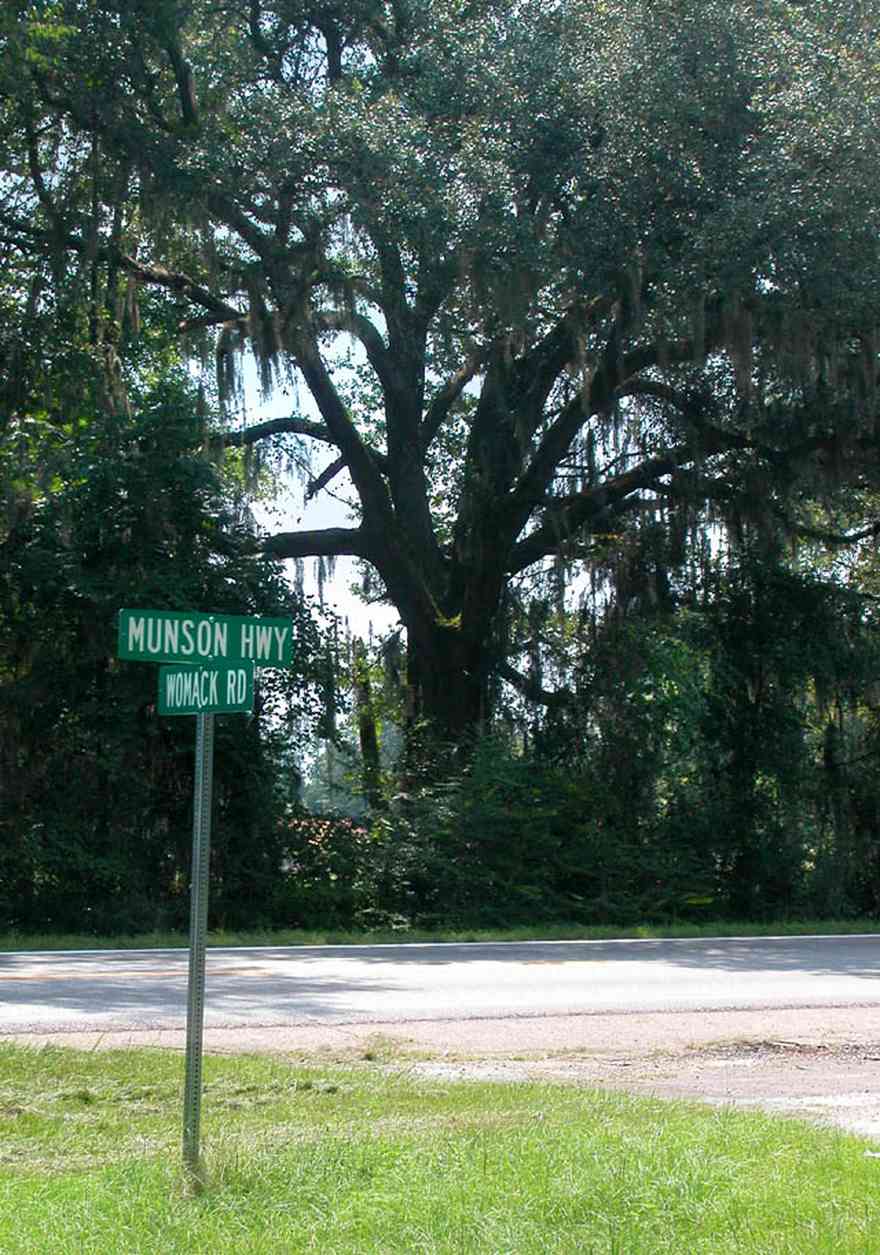
Womack Road is about three miles north of the town of Milton in Santa Rosa County.
-
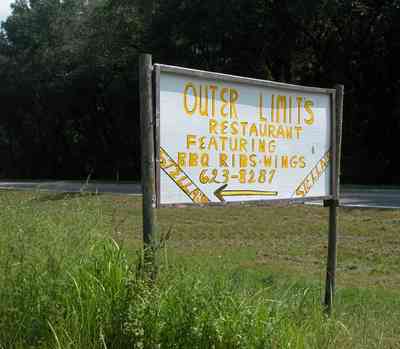
There is a small restaurant about one mile from Munson Highway
-

-

Peanuts are grown on the 35 acre field adjacent to the homestead.
-
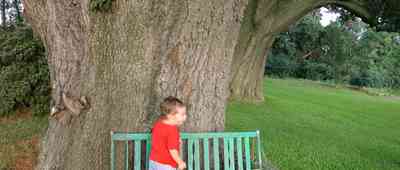
The boots were nailed to the trunk of the oak tree by Jeff Thompson's widow shortly after he died 25 years ago. He is the great-grandfather of John Michael Roush.
-
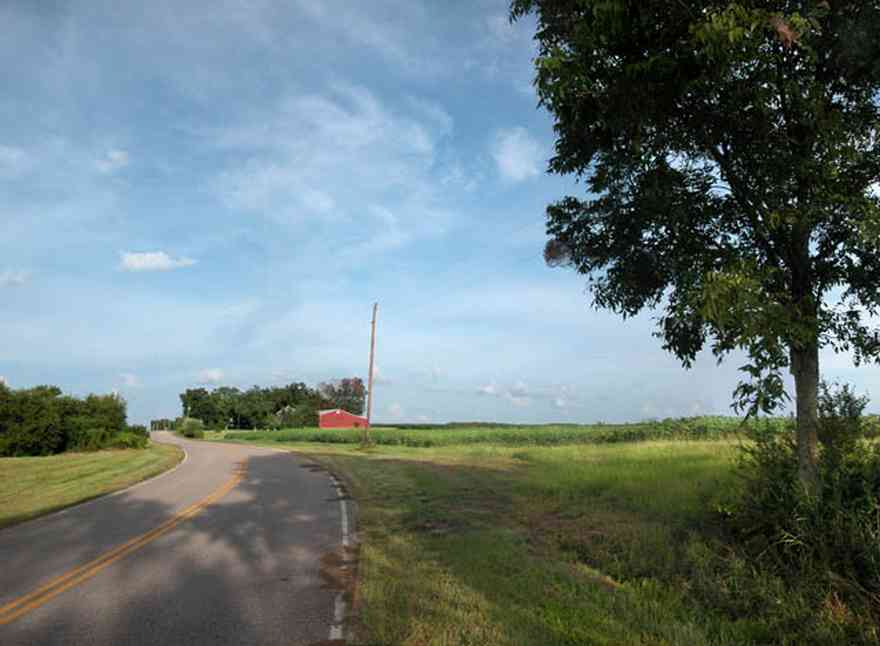
-
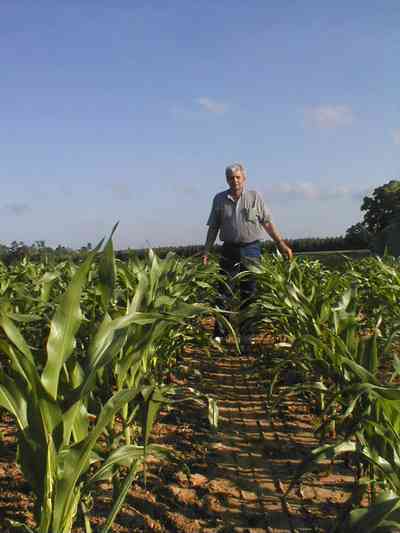
-

A stand of pine trees can be seen on the left of the photograph. Cattle are grazing in the valley.
-

The plowed field is planted in winter wheat.
-

Cattle graze on the winter wheat.
-

Rolls of hay can be seen on the left of the photograph.
-
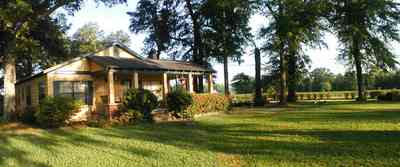
The farm is located on Highway 97.
-
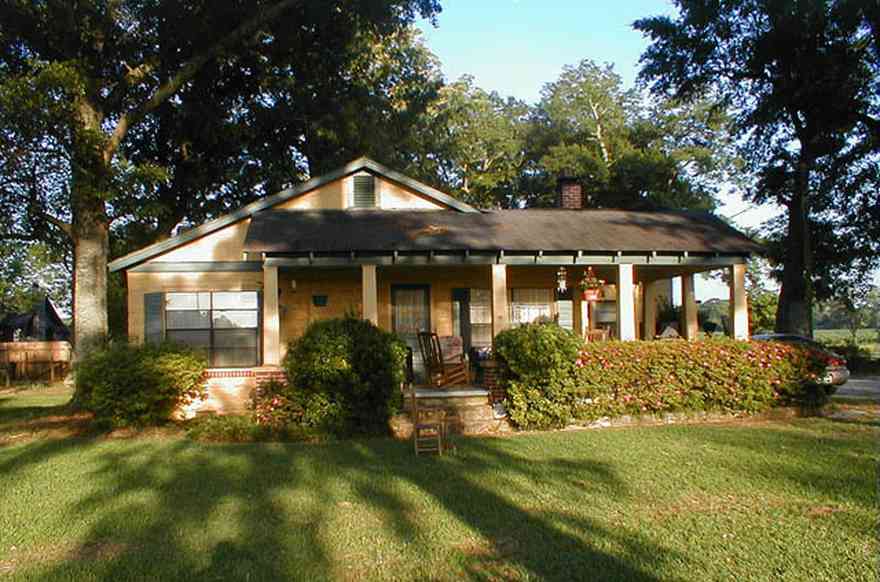
The house harmonizes with its surroundings because of low broad proportions and lack of ornamentation.
-
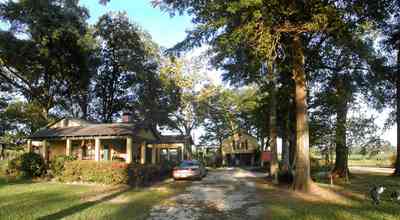
The facade of the home faces west. There is an overstory of large water oaks. An adjoining garage apartment can be seen at the end of the driveway with the barn immediately to the rear.
-
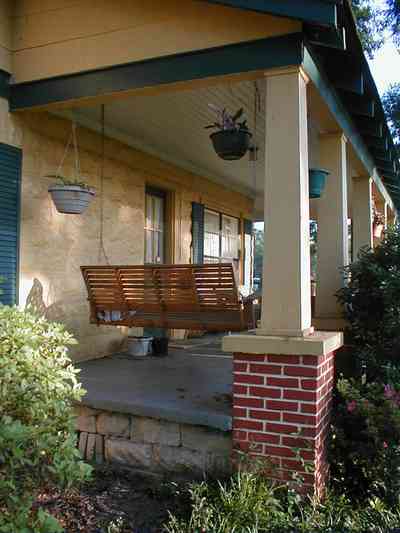
The style of architecture is often referred to as Craftsman. These dwellings display a fine degree of craftsmanship and are constructed of materials left as close as possible to their natural state.
-
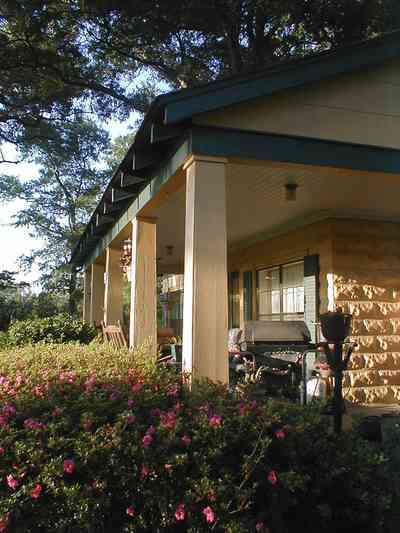
The walls are laid in quarried stone.
-

The conical building is used for drying corn.
-
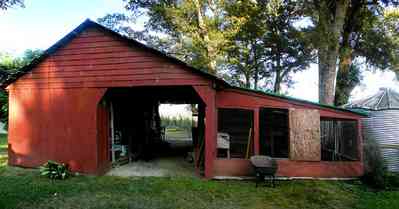
The lean-to on the side of the barn is used as a chicken coop.
-
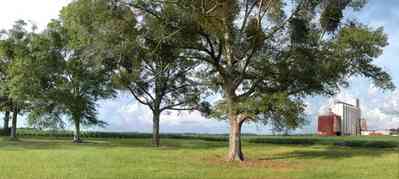
Oak trees line the cotton field adjacent to the Escambia Grain Coop silos.
-
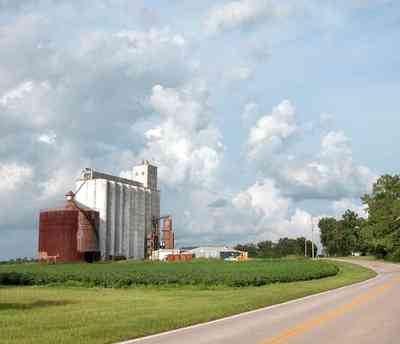
This is the only farm cooperative grain elevator in northwest Florida.
-
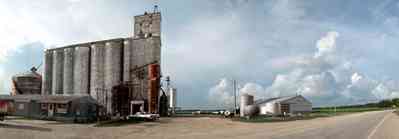
There are three main buildings in the complex. The office is on the left, the grain elevator is immediately behind the office building and the fertilizer house is on the right of the photograph.
-
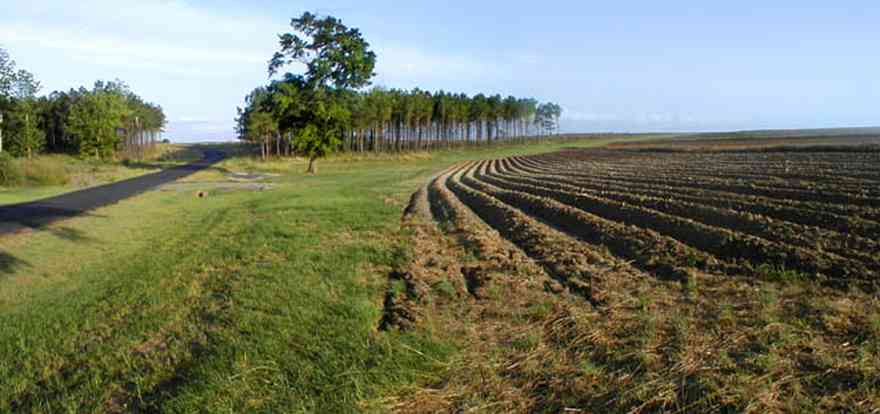
Gobbler Road is in the Walnut Hill Community off Highway 97.
-
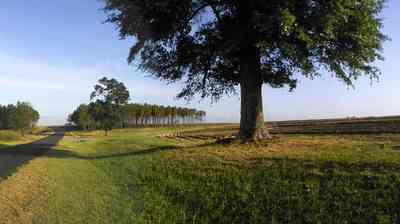
There are thousands of acres in cultivation in the Walnut Hill community planted in a variety of crops.
-

The 60 acre field is located on Highway 97 in the Walnut Hill community.
-
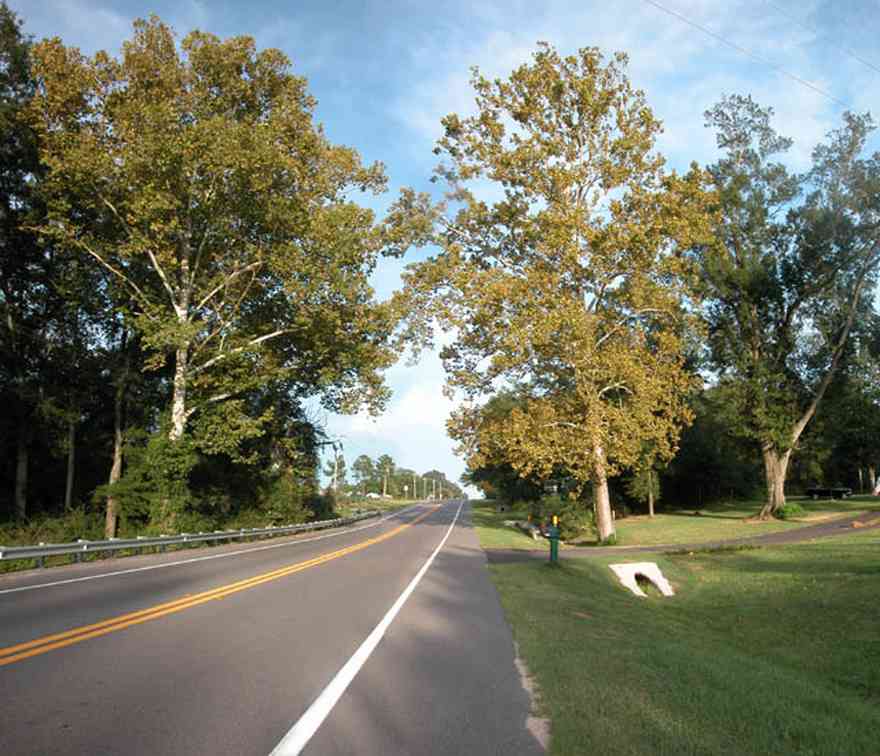
-
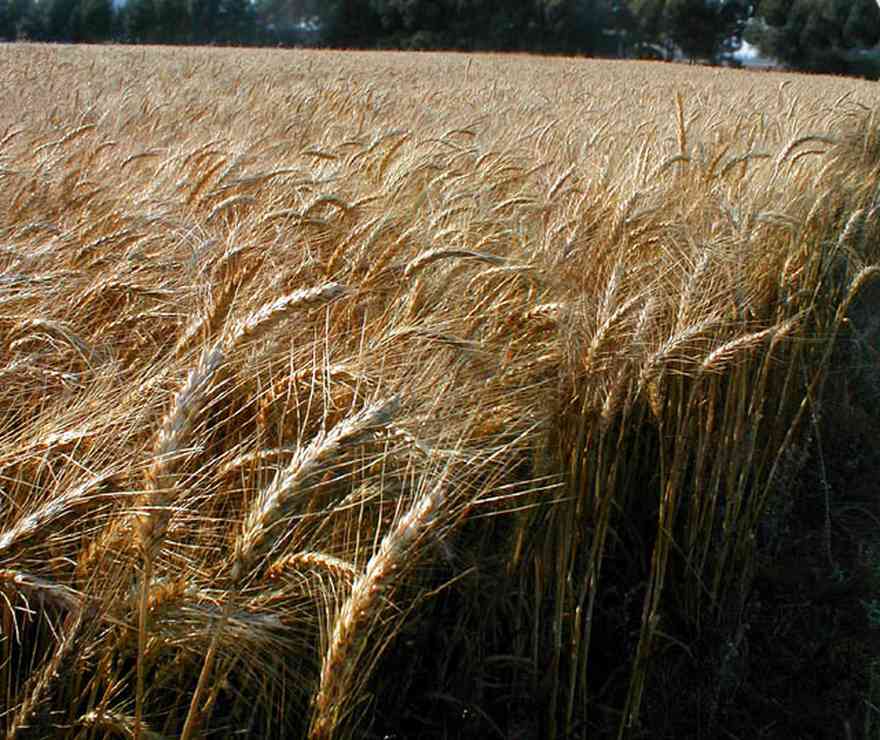
-
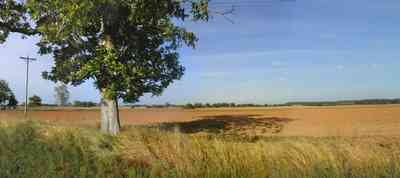
-
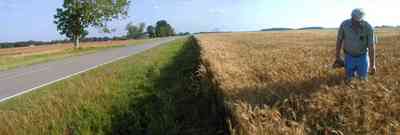
-

The pond is the foreground is one of many catfish ponds in the area. There are over 1,000 such ponds in the neighborhood.
-

-
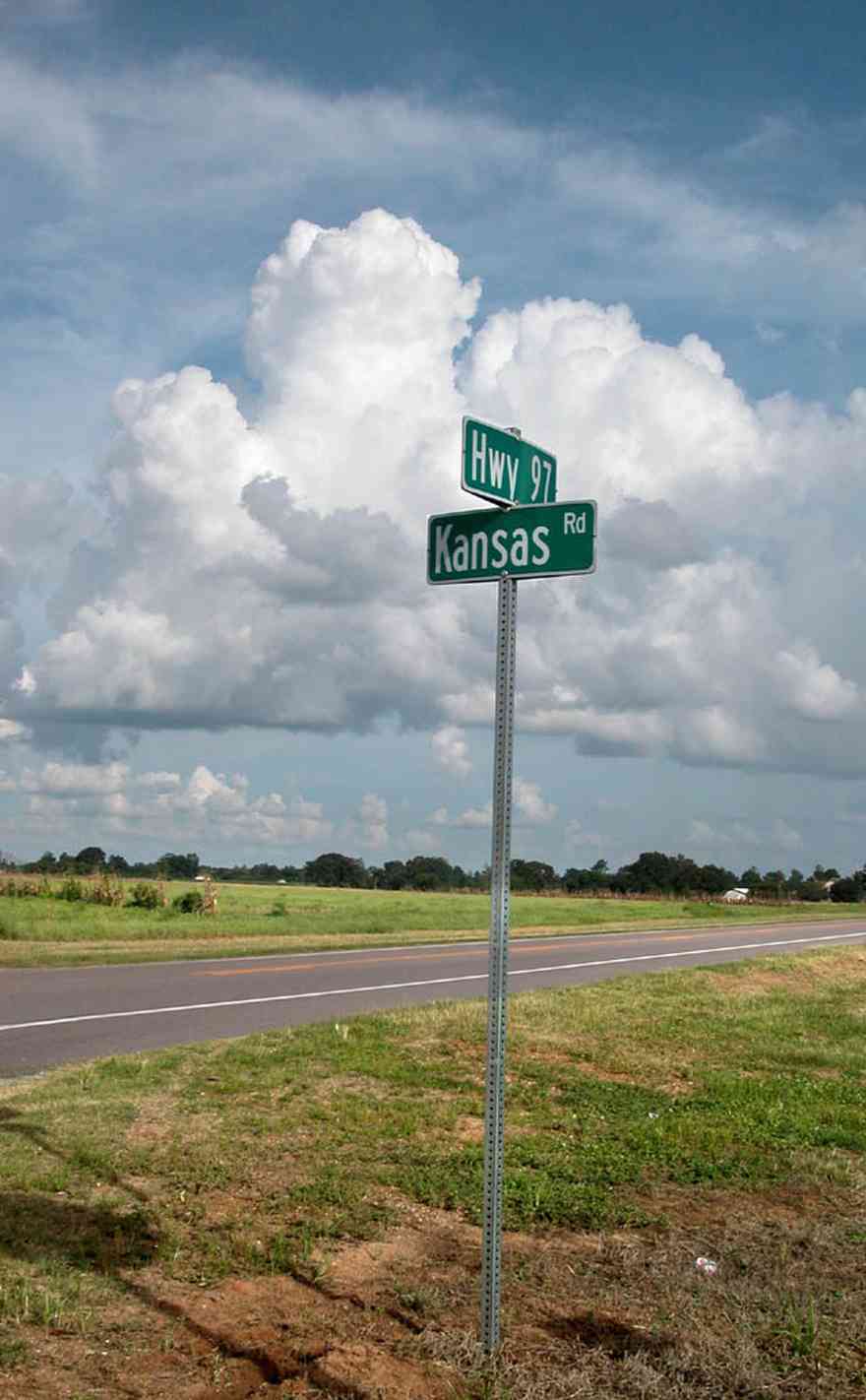
All of the land fronting on Kansas Road is under cultivation as row crops or in use as pasture land.
-

There are cotton fields stretching for several miles on both sides of Kansas Road.
-
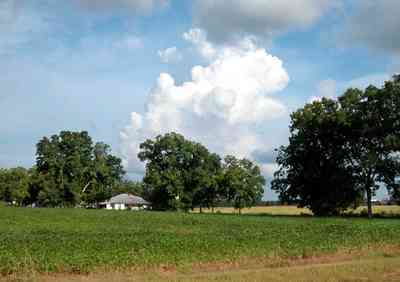
Mennonite farmers are making agriculture a viable way of life in Escambia County.
-

Mike Godwin stands next to an airplane that he is rebuilding.
-
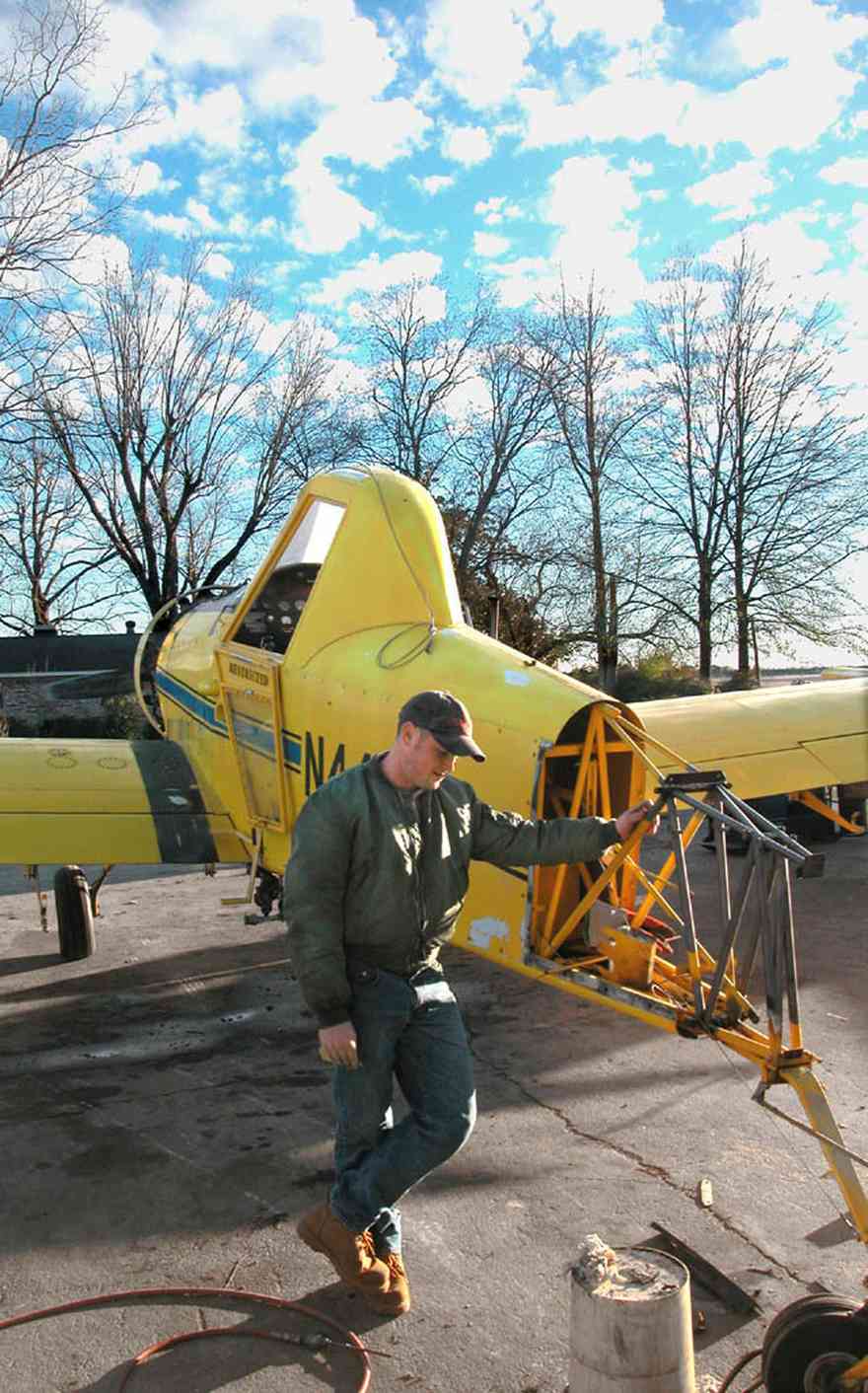
-
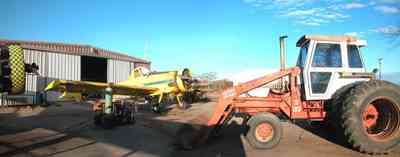
-
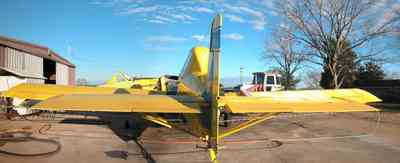
-
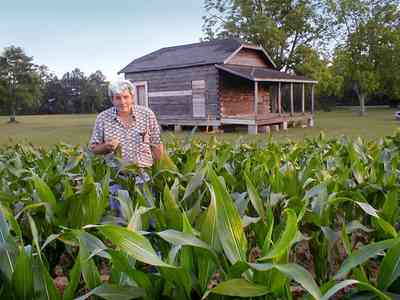
The corn crop will be used for silage to feed dairy cattle.
-
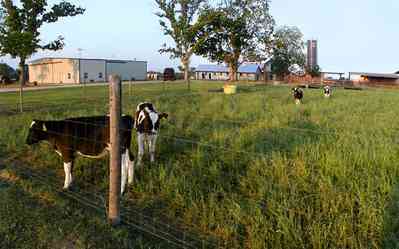
The Van Pelt Dairy Farm is located on Highway 97 in the Walnut Hill community.
-
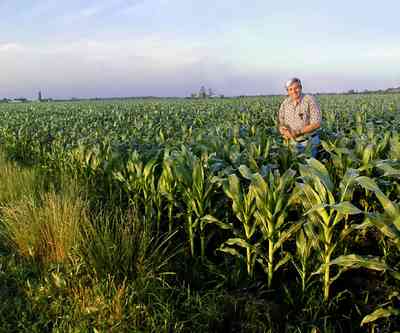
Hundreds of acres of feed corn are grown along Highway 97.
-

In between corn fields there are pastures were the dairy cows graze.
-

Corn fields front Highway 97 for several miles.
-

The south end of the Van Pelt Dairy Farm is bordered by Gobbler Road. There are approximately three miles of corn fields along Gobbler Road which end to the east on Sandy Hollow Road.
-
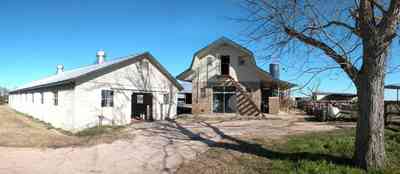
The heifer barn is on the right. The milking barn is in the center of the frame.
-
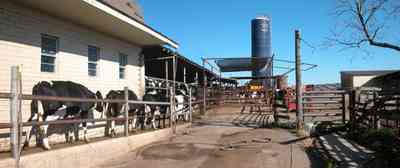
The cows are leaving the milking barn. They are milked in shifts of 16 cows. The entire herd is processed between 1:40 a.m. and 6:30 a.m. and again in the afternoon beginning at 1:00 p.m. finishing around 5:30 p.m..
-
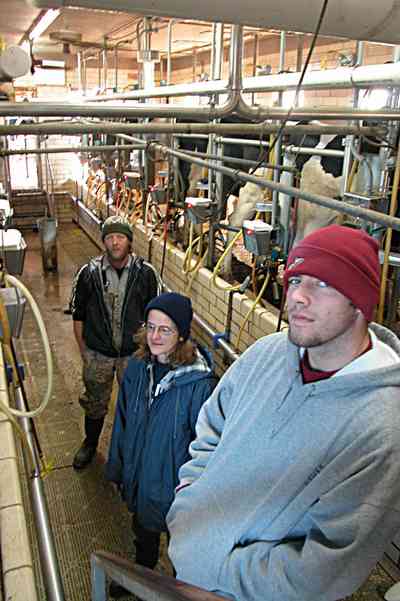
There are three milkers who work in two shifts every day.
-
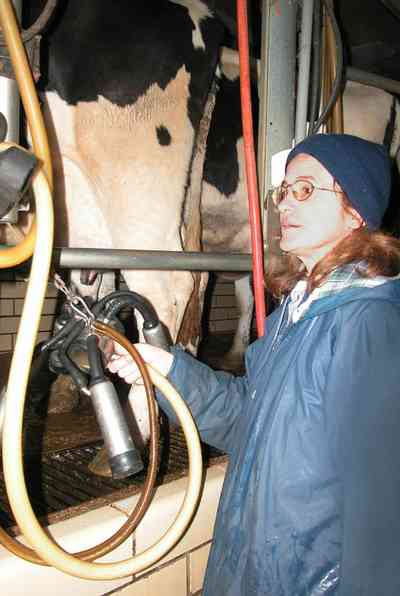
Jan McCune places the milking machine on the cow’s udders. The machine pulls a 30 pound pressure to complete the evacuation process in 5 to 15 minutes depending on the quanitity of milk.
-
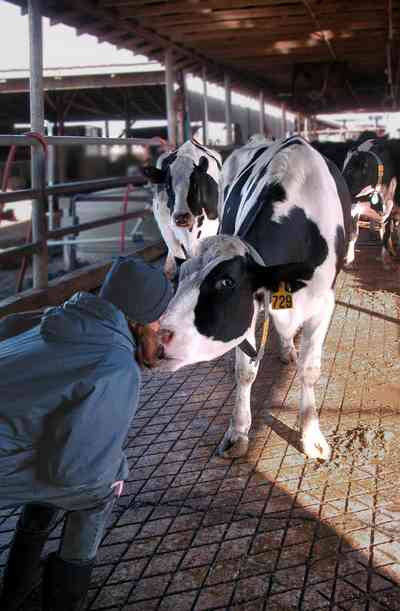
Jan gets a “kiss” from her favorite Mama cow, No. 62. Cows wear collars and are named by number.
-
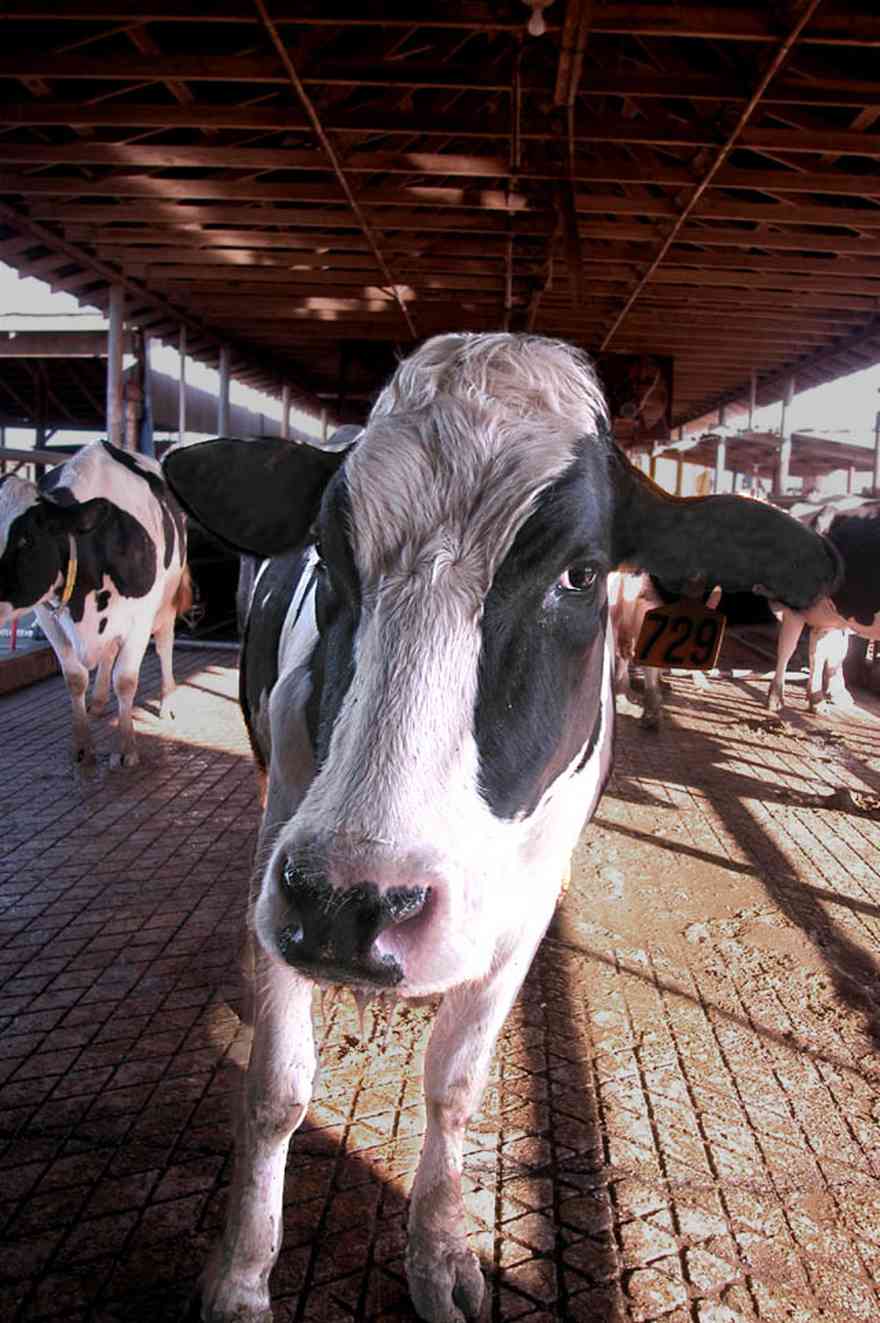
No. 62 is a friendly cow. The cows are in a holding pen, waiting to be called into the milking barn.
-
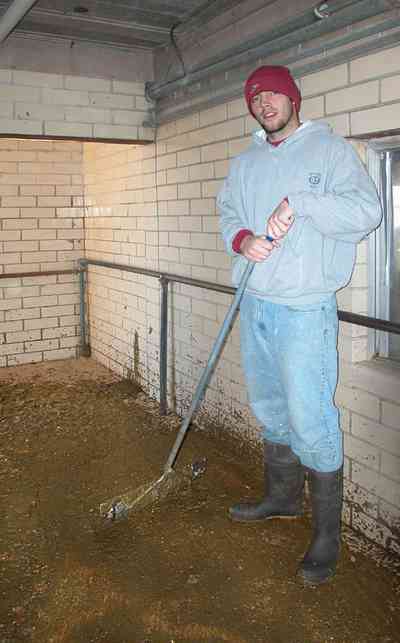
Cleaning the milking barn floor during shifts is a continous task.
-
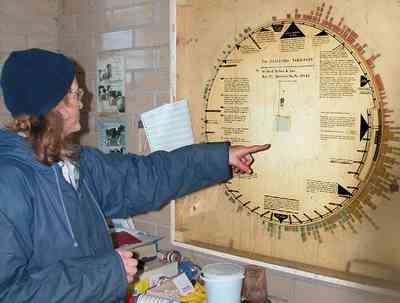
Jan explains the gestation tabulator. The cycles and pregnancy of each cow is plotted.
-

George Van Pelt demonstrates the process of artificial insemination.
-
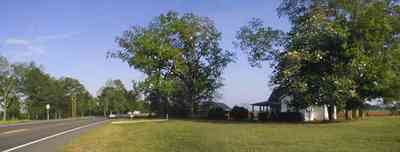
The farm is located on Highway 97 in the Walnut Hill community.
-
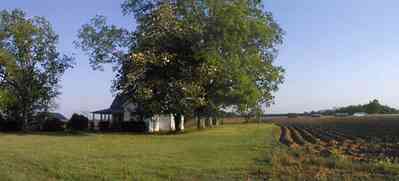
The farm buildings are surrounded by extensive fields in spring cultivation.
-
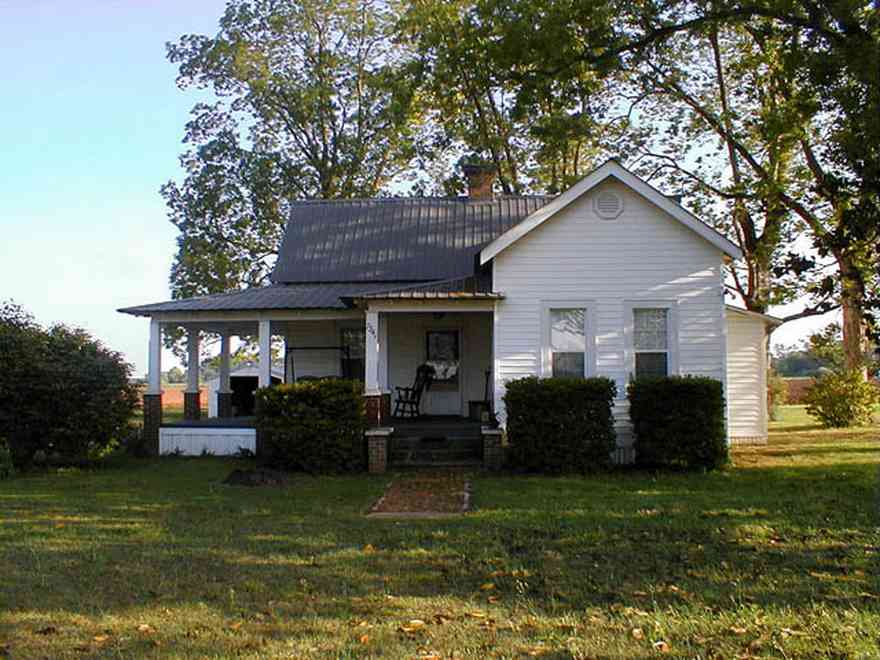
The small farmhouse exhibits traditional Craftsman architectural style.
-
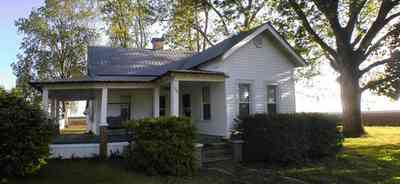
The house is framed with an overstory of pecan trees.
-
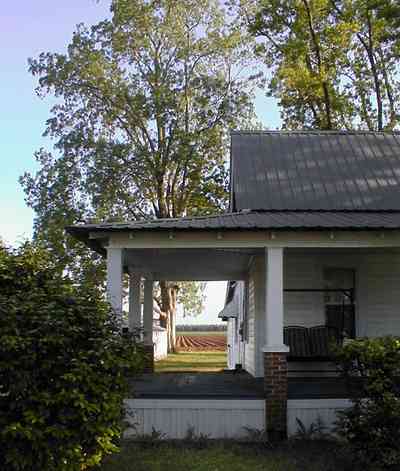
The fields can be seen from the side porch.
-
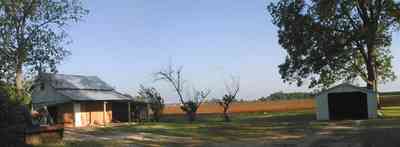
A small barn is located to the east of the main house.
-

The east side of the barn faces Highway 97.
-
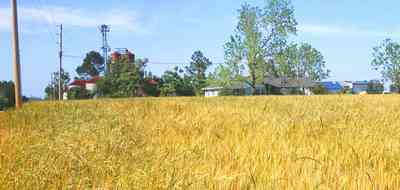
Mennonites moved from Kansas to northern Escambia County. Their farms are well maintained and picturesque.

 The ranch is located on Highway 87 North.
The ranch is located on Highway 87 North. The picturesque ranch is a cattle farm.
The picturesque ranch is a cattle farm. Spanish moss hangs from the oak trees which form a tunnel over the road. For information about Spanish moss, click here.
Spanish moss hangs from the oak trees which form a tunnel over the road. For information about Spanish moss, click here.




 Whimsical sculptures and signs can be found on the Matthews farm.
Whimsical sculptures and signs can be found on the Matthews farm. The property is divided into fenced tracts.
The property is divided into fenced tracts. The farm is located on Hopewell Road.
The farm is located on Hopewell Road. There are two entrances on either side of Hopewell Road. This is the south gate.
There are two entrances on either side of Hopewell Road. This is the south gate. The south road is lined by an avenue of young live oak trees.
The south road is lined by an avenue of young live oak trees. The narrow dirt road is a private driveway.
The narrow dirt road is a private driveway. The road follows the gently rolling hills.
The road follows the gently rolling hills. There are several lakes in the valley. The road winds around the lakes.
There are several lakes in the valley. The road winds around the lakes.

 The highway curves around newly planted fields.
The highway curves around newly planted fields. The farmland is located on a ridge of hills above the Blackwater River basin.
The farmland is located on a ridge of hills above the Blackwater River basin. The front of the farm faces Kleinschmidt Road. The deciduous trees are pecans. There is a grove along the property line on the east side of the farm. The Heil home is a small craftsman cottage in the center of the frame.
The front of the farm faces Kleinschmidt Road. The deciduous trees are pecans. There is a grove along the property line on the east side of the farm. The Heil home is a small craftsman cottage in the center of the frame. A dirt road runs alongside of the east field. Rolls of irrigatioin equipment and outbuildings can be seen in the right side of the frame. The greens can be seen int he center. There is a utility line alongside on the far left.
A dirt road runs alongside of the east field. Rolls of irrigatioin equipment and outbuildings can be seen in the right side of the frame. The greens can be seen int he center. There is a utility line alongside on the far left. The utility buildings and irrigation equipment can be seen in the distance along the tree line.
The utility buildings and irrigation equipment can be seen in the distance along the tree line.
 Piles of watermelons are purchased from July to August at the barn.
Piles of watermelons are purchased from July to August at the barn. Bruce and his family have a complete peanut harvest from planting through boiling.
Bruce and his family have a complete peanut harvest from planting through boiling. The 600 acre farm is divided into summer crops. The butterbean field is adjacent to the barn.
The 600 acre farm is divided into summer crops. The butterbean field is adjacent to the barn. Melvin Holland lends a hand during the butterbean harvest.
Melvin Holland lends a hand during the butterbean harvest. Charles Holland supervises the bagging of beans.
Charles Holland supervises the bagging of beans. Bruce Holland demonstrates soil quality in one of the north fields. The tilled area represents about five acres.
Bruce Holland demonstrates soil quality in one of the north fields. The tilled area represents about five acres. The field is being prepared for the next crop. Soil composition varies widely from field to field. The soil in this area has a high organic content. Soils are composed of sand, clay and organic materials.
The field is being prepared for the next crop. Soil composition varies widely from field to field. The soil in this area has a high organic content. Soils are composed of sand, clay and organic materials. The entrance to the barn and house is on the far right of the photograph. The 5 acre tilled field can be seen on the other side of the road.
The entrance to the barn and house is on the far right of the photograph. The 5 acre tilled field can be seen on the other side of the road. The Bruce Holland farm complex is located on Homer Holland Road in Santa Rosa County, Florida. The peach trees seen in the photo produce about six bushels/60 pounds or 120 one-half pound peaches per tree.
The Bruce Holland farm complex is located on Homer Holland Road in Santa Rosa County, Florida. The peach trees seen in the photo produce about six bushels/60 pounds or 120 one-half pound peaches per tree. Bruce Holland is seen in the foreground of his peach orchard in northwest Florida. The trees have been planted in symmetrical rows every year for the past six years. The orchard has approximately 200 trees, all bearing fruit.
Bruce Holland is seen in the foreground of his peach orchard in northwest Florida. The trees have been planted in symmetrical rows every year for the past six years. The orchard has approximately 200 trees, all bearing fruit. The peanut is a nitrogen-fixing plant. The roots form nodules, which absorb nitrogen from the air and provide enrichment and nutrition to the plant and soil.
The peanut is a nitrogen-fixing plant. The roots form nodules, which absorb nitrogen from the air and provide enrichment and nutrition to the plant and soil. From planting to harvesting the growing cycle takes about four to five months, depending on the variety.
From planting to harvesting the growing cycle takes about four to five months, depending on the variety. Peanuts are actually legumes - not nuts.
Peanuts are actually legumes - not nuts. This 15 acre field was planted in butterbeans. It is irrigated with water from a nearby holding pond.
This 15 acre field was planted in butterbeans. It is irrigated with water from a nearby holding pond. On the American continent, watermelons were grown as early as 1629 in Massachusetts, and prior to 1664 in Florida.
On the American continent, watermelons were grown as early as 1629 in Massachusetts, and prior to 1664 in Florida. Today there are more than 100 different varieties of watermelons. The flesh may be red, pink, orange or yellow.
Today there are more than 100 different varieties of watermelons. The flesh may be red, pink, orange or yellow. The sweetest watermelons grow during long hot summers.
The sweetest watermelons grow during long hot summers. Ninety percent of watermelon is water.
Ninety percent of watermelon is water. Watermelon vines require considerable space. Seeds are planted one inch deep in hills spaced 6 feet apart. As the watermelon plants grows, the vines converge and the field becomes a sea of green vines.
Watermelon vines require considerable space. Seeds are planted one inch deep in hills spaced 6 feet apart. As the watermelon plants grows, the vines converge and the field becomes a sea of green vines. The watermelon require a long growing season with relatively high temperatures. Daytime temperatures between 70 and 80 degrees F and nighttime temperatures between 65 and 70 degrees F are ideal.
The watermelon require a long growing season with relatively high temperatures. Daytime temperatures between 70 and 80 degrees F and nighttime temperatures between 65 and 70 degrees F are ideal. Once picked, uncut watermelon can be stored for about 2 weeks at room temperature.
Once picked, uncut watermelon can be stored for about 2 weeks at room temperature. The flesh of the melon should be deep colored with mature seeds. Most watermelons have dark brown or black seeds.
The flesh of the melon should be deep colored with mature seeds. Most watermelons have dark brown or black seeds. Harvesting is particularly critical because watermelons do not continue to ripen after they have been removed from the vine. They should be picked at full maturity.
Harvesting is particularly critical because watermelons do not continue to ripen after they have been removed from the vine. They should be picked at full maturity. Watermelons are low in calories and very nutritious. Watermelon is high in lycopene, second only to tomatoes.
Watermelons are low in calories and very nutritious. Watermelon is high in lycopene, second only to tomatoes. The Holland family settled the area over 100 years ago. Bruce Holland is a well known farmer who sells produce at his barn on Hwy 178. His farm has been featured on the WEAR TV 3 feature "Our Acre".
The Holland family settled the area over 100 years ago. Bruce Holland is a well known farmer who sells produce at his barn on Hwy 178. His farm has been featured on the WEAR TV 3 feature "Our Acre". The church is located at the corner of Chumukla Highway and 178.
The church is located at the corner of Chumukla Highway and 178. The little church is nestled between cotton fields in western Santa Rosa County.
The little church is nestled between cotton fields in western Santa Rosa County. The craftsman style cottage is evocative of the farm houses of the 1920's and 30's. It sits on the edge of a cotton field.
The craftsman style cottage is evocative of the farm houses of the 1920's and 30's. It sits on the edge of a cotton field. Melvin Holland sells peanuts at the festival.
Melvin Holland sells peanuts at the festival. There is a display of John Deere® tractors alongside of the farm museum.
There is a display of John Deere® tractors alongside of the farm museum. An original water well is located east of the farm house.
An original water well is located east of the farm house.



 The board fence separates the horse farm from the neighboring estate.
The board fence separates the horse farm from the neighboring estate. Womack Road is about three miles north of the town of Milton in Santa Rosa County.
Womack Road is about three miles north of the town of Milton in Santa Rosa County. There is a small restaurant about one mile from Munson Highway
There is a small restaurant about one mile from Munson Highway
 Peanuts are grown on the 35 acre field adjacent to the homestead.
Peanuts are grown on the 35 acre field adjacent to the homestead. The boots were nailed to the trunk of the oak tree by Jeff Thompson's widow shortly after he died 25 years ago. He is the great-grandfather of John Michael Roush.
The boots were nailed to the trunk of the oak tree by Jeff Thompson's widow shortly after he died 25 years ago. He is the great-grandfather of John Michael Roush.

 A stand of pine trees can be seen on the left of the photograph. Cattle are grazing in the valley.
A stand of pine trees can be seen on the left of the photograph. Cattle are grazing in the valley. The plowed field is planted in winter wheat.
The plowed field is planted in winter wheat. Cattle graze on the winter wheat.
Cattle graze on the winter wheat. Rolls of hay can be seen on the left of the photograph.
Rolls of hay can be seen on the left of the photograph. The farm is located on Highway 97.
The farm is located on Highway 97. The house harmonizes with its surroundings because of low broad proportions and lack of ornamentation.
The house harmonizes with its surroundings because of low broad proportions and lack of ornamentation. The facade of the home faces west. There is an overstory of large water oaks. An adjoining garage apartment can be seen at the end of the driveway with the barn immediately to the rear.
The facade of the home faces west. There is an overstory of large water oaks. An adjoining garage apartment can be seen at the end of the driveway with the barn immediately to the rear. The style of architecture is often referred to as Craftsman. These dwellings display a fine degree of craftsmanship and are constructed of materials left as close as possible to their natural state.
The style of architecture is often referred to as Craftsman. These dwellings display a fine degree of craftsmanship and are constructed of materials left as close as possible to their natural state. The walls are laid in quarried stone.
The walls are laid in quarried stone. The conical building is used for drying corn.
The conical building is used for drying corn. The lean-to on the side of the barn is used as a chicken coop.
The lean-to on the side of the barn is used as a chicken coop. Oak trees line the cotton field adjacent to the Escambia Grain Coop silos.
Oak trees line the cotton field adjacent to the Escambia Grain Coop silos. This is the only farm cooperative grain elevator in northwest Florida.
This is the only farm cooperative grain elevator in northwest Florida. There are three main buildings in the complex. The office is on the left, the grain elevator is immediately behind the office building and the fertilizer house is on the right of the photograph.
There are three main buildings in the complex. The office is on the left, the grain elevator is immediately behind the office building and the fertilizer house is on the right of the photograph. Gobbler Road is in the Walnut Hill Community off Highway 97.
Gobbler Road is in the Walnut Hill Community off Highway 97. There are thousands of acres in cultivation in the Walnut Hill community planted in a variety of crops.
There are thousands of acres in cultivation in the Walnut Hill community planted in a variety of crops. The 60 acre field is located on Highway 97 in the Walnut Hill community.
The 60 acre field is located on Highway 97 in the Walnut Hill community.



 The pond is the foreground is one of many catfish ponds in the area. There are over 1,000 such ponds in the neighborhood.
The pond is the foreground is one of many catfish ponds in the area. There are over 1,000 such ponds in the neighborhood.
 All of the land fronting on Kansas Road is under cultivation as row crops or in use as pasture land.
All of the land fronting on Kansas Road is under cultivation as row crops or in use as pasture land. There are cotton fields stretching for several miles on both sides of Kansas Road.
There are cotton fields stretching for several miles on both sides of Kansas Road. Mennonite farmers are making agriculture a viable way of life in Escambia County.
Mennonite farmers are making agriculture a viable way of life in Escambia County. Mike Godwin stands next to an airplane that he is rebuilding.
Mike Godwin stands next to an airplane that he is rebuilding.


 The corn crop will be used for silage to feed dairy cattle.
The corn crop will be used for silage to feed dairy cattle. The Van Pelt Dairy Farm is located on Highway 97 in the Walnut Hill community.
The Van Pelt Dairy Farm is located on Highway 97 in the Walnut Hill community. Hundreds of acres of feed corn are grown along Highway 97.
Hundreds of acres of feed corn are grown along Highway 97. In between corn fields there are pastures were the dairy cows graze.
In between corn fields there are pastures were the dairy cows graze. Corn fields front Highway 97 for several miles.
Corn fields front Highway 97 for several miles. The south end of the Van Pelt Dairy Farm is bordered by Gobbler Road. There are approximately three miles of corn fields along Gobbler Road which end to the east on Sandy Hollow Road.
The south end of the Van Pelt Dairy Farm is bordered by Gobbler Road. There are approximately three miles of corn fields along Gobbler Road which end to the east on Sandy Hollow Road. The heifer barn is on the right. The milking barn is in the center of the frame.
The heifer barn is on the right. The milking barn is in the center of the frame. The cows are leaving the milking barn. They are milked in shifts of 16 cows. The entire herd is processed between 1:40 a.m. and 6:30 a.m. and again in the afternoon beginning at 1:00 p.m. finishing around 5:30 p.m..
The cows are leaving the milking barn. They are milked in shifts of 16 cows. The entire herd is processed between 1:40 a.m. and 6:30 a.m. and again in the afternoon beginning at 1:00 p.m. finishing around 5:30 p.m.. There are three milkers who work in two shifts every day.
There are three milkers who work in two shifts every day. Jan McCune places the milking machine on the cow’s udders. The machine pulls a 30 pound pressure to complete the evacuation process in 5 to 15 minutes depending on the quanitity of milk.
Jan McCune places the milking machine on the cow’s udders. The machine pulls a 30 pound pressure to complete the evacuation process in 5 to 15 minutes depending on the quanitity of milk. Jan gets a “kiss” from her favorite Mama cow, No. 62. Cows wear collars and are named by number.
Jan gets a “kiss” from her favorite Mama cow, No. 62. Cows wear collars and are named by number. No. 62 is a friendly cow. The cows are in a holding pen, waiting to be called into the milking barn.
No. 62 is a friendly cow. The cows are in a holding pen, waiting to be called into the milking barn. Cleaning the milking barn floor during shifts is a continous task.
Cleaning the milking barn floor during shifts is a continous task. Jan explains the gestation tabulator. The cycles and pregnancy of each cow is plotted.
Jan explains the gestation tabulator. The cycles and pregnancy of each cow is plotted. George Van Pelt demonstrates the process of artificial insemination.
George Van Pelt demonstrates the process of artificial insemination. The farm is located on Highway 97 in the Walnut Hill community.
The farm is located on Highway 97 in the Walnut Hill community. The farm buildings are surrounded by extensive fields in spring cultivation.
The farm buildings are surrounded by extensive fields in spring cultivation. The small farmhouse exhibits traditional Craftsman architectural style.
The small farmhouse exhibits traditional Craftsman architectural style. The house is framed with an overstory of pecan trees.
The house is framed with an overstory of pecan trees. The fields can be seen from the side porch.
The fields can be seen from the side porch. A small barn is located to the east of the main house.
A small barn is located to the east of the main house. The east side of the barn faces Highway 97.
The east side of the barn faces Highway 97. Mennonites moved from Kansas to northern Escambia County. Their farms are well maintained and picturesque.
Mennonites moved from Kansas to northern Escambia County. Their farms are well maintained and picturesque. One Tank of Gas
One Tank of Gas